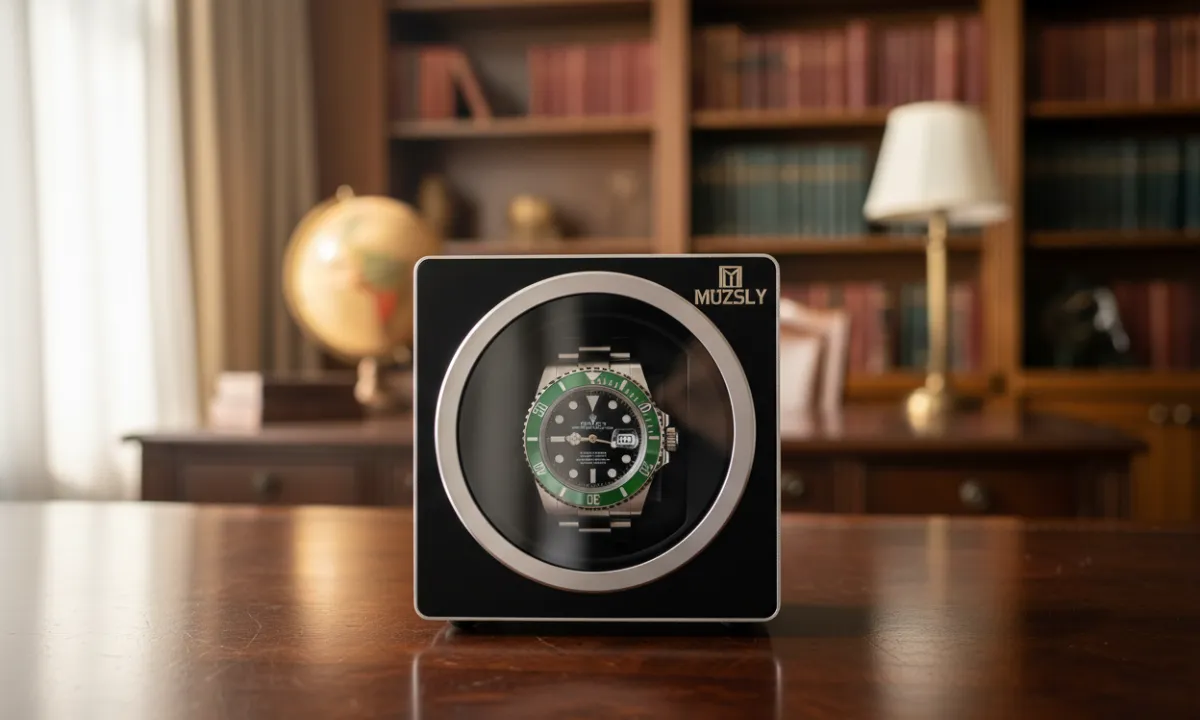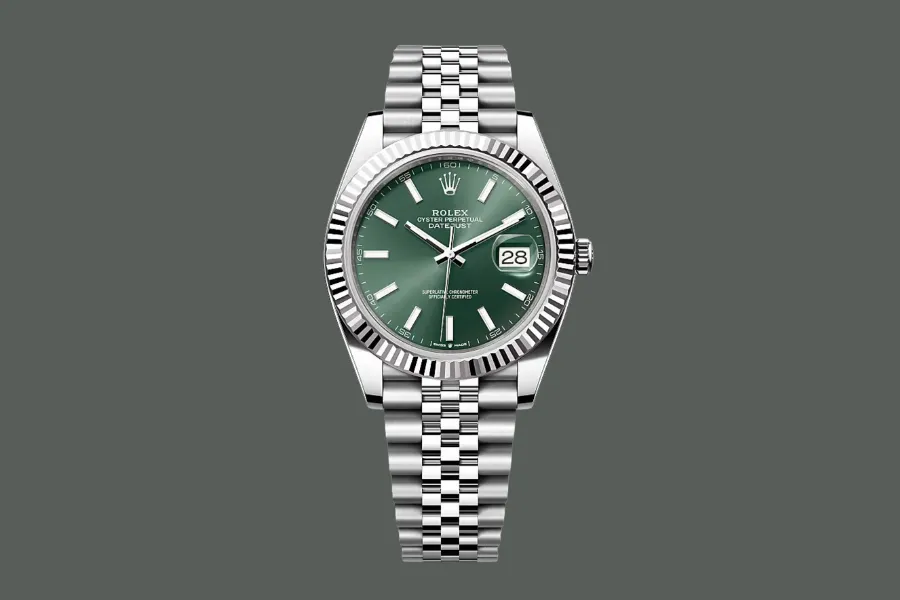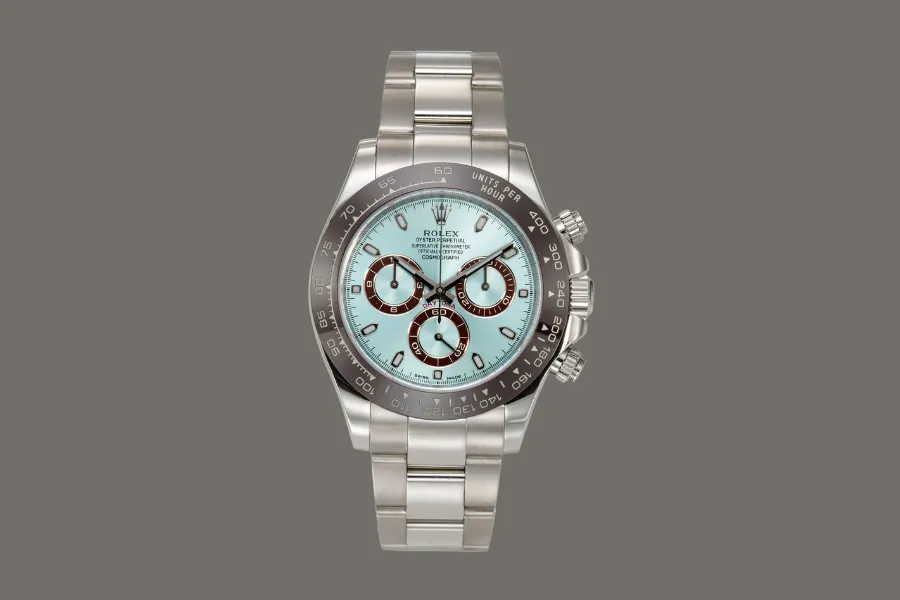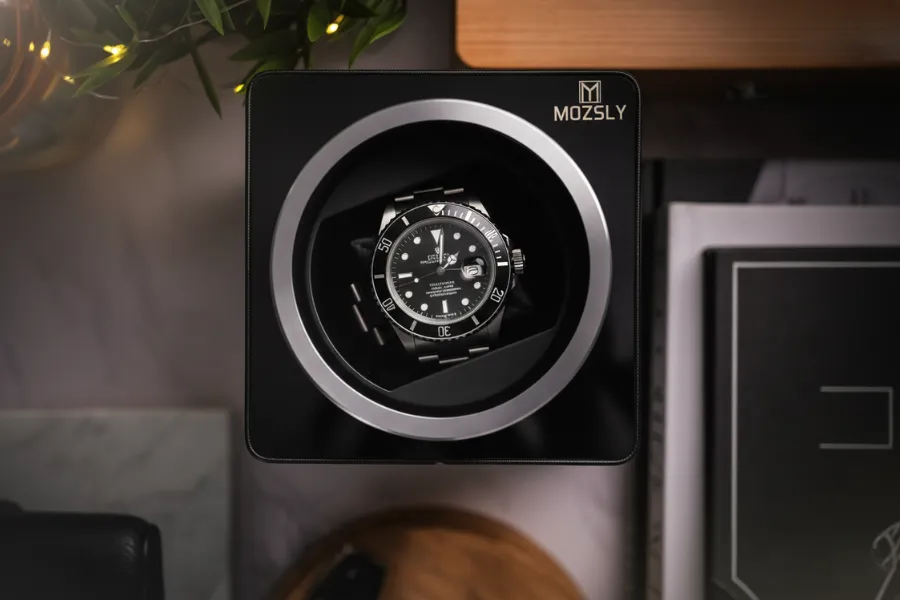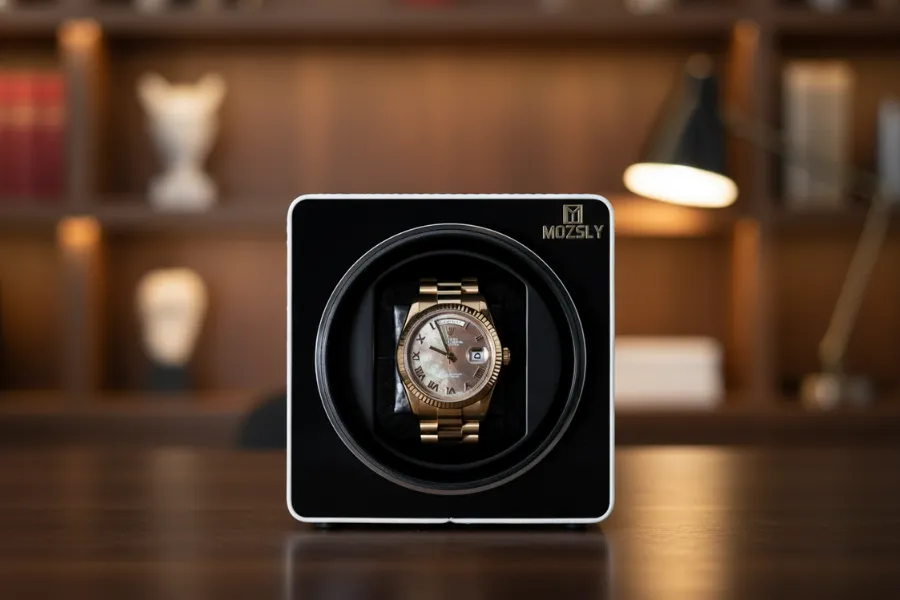Share This Post
Yes — it’s okay to leave a Rolex on a watch winder. I say that confidently because modern Rolex movements have built-in safety features and are engineered to handle continuous motion. You might worry because a Rolex is an expensive investment, and the internet has conflicting advice. I get it — I felt the same way when I bought my first Submariner.
Calm down: Rolex designs its movements to resist overwinding and to work with proper watch winders. In this article, I’ll explain the engineering, show exact watch winder settings, and give a clear action plan so you can protect your watch without stress.
How Rolex Prevents Watch Winder Damage?
Rolex doesn’t leave protection to chance. Their movements include mechanical safety features and modern lubricants that make them compatible with a good automatic watch winder.
Two simple concepts are crucial: the slip clutch and the way the movement is built to accept continuous motion. You don’t need a mechanical PhD to understand this — think of them as built-in guards that stop damage before it happens.
The Slip Clutch System Explained
First, let me define a slip clutch: it’s a small part inside the winding system that prevents the mainspring from being wound too tightly. In simple terms, it limits how much tension can build.
Think of it like a car clutch. When you press too hard on the gas and the wheels slip, the clutch protects the engine. The slip clutch in a Rolex does something similar — it lets the winding action slip once the mainspring is fully wound. Sometimes you’ll hear a soft “tick-tick” when the watch is fully wound. That sound is the clutch doing its job.
This is why overwinding — a common worry — is basically impossible on modern Rolex watches.
Why Overwinding Is Impossible?
Rolex movements are engineered for continuous motion. Inside, the mainspring stores energy, and once it’s full, the slip clutch prevents extra tension. Also, automatic movements are built to accept more stress than a watch winder will provide. A proper winder, set correctly, actually mimics the motion of your wrist and won’t push the movement beyond its limits.
Quick fact: automatic movements were designed to run continuously when needed. So a winder, set to match natural motion, doesn’t exceed what your watch is built for. (See watchmaker discussions: Hodinkee on winders.)
Correct Watch Winder Settings for Your Rolex
If you want the safe, practical part: here’s what to set. First, I’ll define TPD since you’ll see it a lot.
TPD = Turns Per Day. It tells the winder how many full rotations it makes each day.
Set your watch winder to the right TPD and rotation direction, and you’ll be fine.
Universal Rolex Settings
- Standard setting: 650 TPD with bidirectional rotation.
- Why this works: Rolex standardized many movements in the 2000s. 650 TPD bidirectional mimics average wrist movement for most modern Rolex models, and fits many modern Rolex calibers.
- Bidirectional rotation: that means the winder turns both ways, like your wrist does during normal wear.
If you don’t like numbers, just remember: 650 TPD, bidirectional — it’s the safe default.
Step-by-Step Setup Guide
Follow this foolproof setup:
- Set winder to 650 TPD, bidirectional.
- Place your Rolex on the winder cushion securely.
- Run the winder for 48 hours.
- After 48 hours, check the timekeeping against a reliable clock.
- If the watch is losing or gaining noticeably, adjust TPD up to 750 and re-check.
Signs to watch for:
- Gaining many minutes per day (too much winding).
- Losing time (not enough motion).
- If you see either, adjust TPD. Most likely, you won’t need changes.
Popular Model Specifications
Here’s a simple reference — all these modern models do well on 650 TPD, bidirectional:
- Submariner — 650 TPD, bidirectional.
- Datejust — 650 TPD, bidirectional.
- GMT-Master — 650 TPD, bidirectional.
- Daytona — 650 TPD, bidirectional.
Note: caliber means the movement model inside the watch. Newer Rolex calibers (like the Caliber 32xx series) are standardized, so one setting fits most of them. If you own a vintage Rolex, settings may vary — and hand-winding vintage watches is often the safer route.
When You Actually Need a Watch Winder?
Do you really need one? It depends on how you use your watches.
Perfect Scenarios for Winders
A watch winder is helpful when:
- You own 3+ automatic watches and rotate them.
- You have complicated watches (GMT, annual calendar, moon phase).
- You wear a Rolex less than 3 times per week.
- You travel often and like your watch to be ready to wear right away.
Complicated watches take time to reset. I once had an annual-calendar watch that took ten minutes to set — a winder saved me that time every morning. Small conveniences add up.
Cost vs Convenience Analysis
Consider this:
- Quality watch winder: $100+ (single or dual).
- Time to manually wind and set one complicated watch: 5–15 minutes each time.
If you wear a single Rolex daily, skip the winder and save money. If you’re a collector with multiple pieces, a good winder is worth it.
And one more note: cheap winders often lack proper TPD control and can be noisy. Poor design is what causes problems, not winders per se. So avoid bargain models.
Debunking Watch Winder Myths
A lot of fear surrounds winders. Let’s clear it up.
“Winders Cause Excessive Wear” – The Truth
Truth: A properly set winder creates less motion than daily wear. Rolex movements use modern lubricants made to handle continuous operation. A quality winder actually helps distribute oils evenly, preventing them from settling or thickening.
In short, correct use does not cause excessive wear. (See watchmaker notes on lubrication — WatchTime/Hodinkee.)
“Overwinding Will Break My Rolex”
Overwinding a modern automatic Rolex is essentially impossible. The sliding mainspring and slip clutch stop the spring from building too much tension. That’s mechanical design, not luck. Good winders stay within safe ranges anyway — for example, Mozsly watch winder designs offer custom TPD settings that keep motion within safe limits.
Expert Validation and Peace of Mind
Let’s bring in what professionals say.
What Watchmakers Actually Say?
Many watchmakers and independent service centers agree: a quality watch winder, used properly, is safe for Rolex. They add that winders can help keep a watch’s oils from congealing if the watch sits for long periods. Authorized dealers don’t usually warn against winders if customers use them correctly. (See technical commentary from watch industry sources such as Hodinkee and WatchTime.)
The Bottom Line on Safety
You can leave a Rolex on a quality watch winder indefinitely if you use the correct settings. The engineering inside modern Rolex movements — slip clutch, sliding mainspring, and modern lubricants — protects the watch. Using a winder correctly is generally considered safe, but check your warranty terms or ask your dealer to be sure.
Choosing the Right Watch Winder
If you decide to buy one, pick quality. Features matter.
Essential Features for Rolex Compatibility
Look for:
- Adjustable TPD (minimum range 600–800).
- Bidirectional rotation (or selectable directions).
- Quiet operation (Almost silent).
- Dual power options (AC and battery).
Why do these matter:
- Adjustable TPD lets you match the watch.
- Bidirectional mimics wrist motion.
- Quietness keeps it usable at night.
- Dual power gives flexibility for travel.
Why Mozsly Stands Out for Rolex
I want to mention a real product that gets the basics right: the Mozsly watch winder. It uses a reliable Japanese Mabuchi motor, offers AC/battery power, and has shielded motors to lower magnetization risk. It has precise TPD control, three-direction options, and multiple TPD settings (650, 850, 1,050, 1,250) for flexibility.
I’m not pushing you — I’m just pointing out a model that covers the features above without hype.
Real-World Performance
Practical benefits I’ve noticed from decent winders:
- Adjustable TPD range (650–1250) covers most needs.
- Soft cushions fit big and small wrists (6.7″–8.7″) and up to 55mm dials.
- Daisy-chain capability helps collectors power several at once.
These aren’t luxury points — they solve real user problems. I once had a cheap winder that was loud and spun only one way; switching to a better model was a relief.
Conclusion
Here’s what I’d do if I were you:
- If you own a modern Rolex and rotate it or wear it rarely, get a quality automatic watch winder and set it to 650 TPD, bidirectional.
- If you wear one Rolex every day, skip the winder and save the cash.
- If you buy a winder, choose one with adjustable TPD, bidirectional modes, quiet motors, and dual power — the Mozsly watch winder is an example that meets these points.
- Check your watch after 48 hours on the winder and then periodically for timekeeping.
Trust the engineering, but stay sensible. Use the right settings. And if you still worry, ask your Rolex service center or a trusted watchmaker — I did that too, and it calmed me down. Now go enjoy your watch.
Related Post's
Featured Video
Provide an email subscription feature for users to sign up for updates.
Follow the world of watches and cigars for exclusive content!
By subscribing to our newsletter, you will be the first to receive notifications of our latest articles, popular posts and special events.

